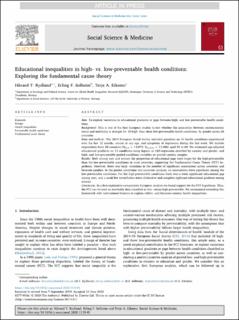| dc.contributor.author | Rydland, Håvard Thorsen | |
| dc.contributor.author | Solheim, Erling | |
| dc.contributor.author | Eikemo, Terje Andreas | |
| dc.date.accessioned | 2020-11-23T08:35:54Z | |
| dc.date.available | 2020-11-23T08:35:54Z | |
| dc.date.created | 2020-07-20T12:43:47Z | |
| dc.date.issued | 2020 | |
| dc.identifier.citation | Social Science and Medicine. 2020, 00:113145 1-10. | en_US |
| dc.identifier.issn | 0277-9536 | |
| dc.identifier.uri | https://hdl.handle.net/11250/2688979 | |
| dc.description.abstract | Aim: To explore variations in educational gradients or gaps between high- and low-preventable health conditions. Background: This is one of the first European studies to test whether the association between socioeconomic status and morbidity is stronger for 10 high- than three low-preventable health conditions, by gender across 20 countries. Data and methods: The 2014 European Social Survey included questions on 11 health conditions experienced over the last 12 months, cancer at any age, and symptoms of depression during the last week. We include respondents from 20 countries (Nmen = 12,073; Nwomen = 13,488) aged 25 to 69. We estimated age-adjusted educational gradients on 13 conditions using logistic or OLS-regression stratified by country and gender, and high- and low-preventable pooled conditions variables on pooled country samples. Results: Both among men and women the proportion of educational gaps were larger for the high-preventable than the low-preventable conditions in most countries, supporting the Fundamental Cause Theory (FCT) hypothesis. However, there was large variations in the number of significant associations across countries and between genders. In the pooled conditions and countries analysis, no associations were significant among the low-preventable conditions. For the high-preventable conditions there was a weak significant educational gap among men, and a weak but nevertheless more distinctive and complete sigificant educational gradient among women. Conclusion: In a first explorative comparative European analysis we found support for the FCT hypothesis. Thus, the FCT can be used on morbidity data classified as low- versus high-preventable. We recommend extending this framework with institutional theories to explain within- and between-country health inequalities. | en_US |
| dc.language.iso | eng | en_US |
| dc.publisher | Elsevier | en_US |
| dc.title | Educational inequalities in high- vs. low-preventable health conditions: Exploring the fundamental cause theory | en_US |
| dc.type | Peer reviewed | en_US |
| dc.type | Journal article | en_US |
| dc.description.version | publishedVersion | en_US |
| dc.source.pagenumber | 1-10 | en_US |
| dc.source.volume | 00:113145 | en_US |
| dc.source.journal | Social Science and Medicine | en_US |
| dc.identifier.doi | 10.1016/j.socscimed.2020.113145 | |
| dc.identifier.cristin | 1819853 | |
| dc.description.localcode | DOI: 10.1016/j.socscimed.2020.113145. 0277-9536/ © 2020 The Author(s). Published by Elsevier Ltd. This is an open access article under the CC BY license (http://creativecommons.org/licenses/BY/4.0/). | en_US |
| cristin.ispublished | true | |
| cristin.fulltext | postprint | |
| cristin.qualitycode | 2 | |
